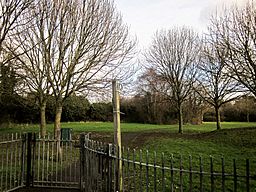Pen Park Hole facts for kids
Quick facts for kids Pen Park Hole |
|
|---|---|

Pen Park. The cavern is screened by trees in the background
|
|
| Location | Southmead, Bristol, UK |
| OS grid | ST 5853 7922 |
| Depth | 61 metres (200 ft) |
| Length | 250 metres (820 ft) |
| Elevation | 76 metres (249 ft) |
| Discovery | 1669 |
| Geology | Limestone |
| Access | locked, controlled by Bristol City Council |
| Registry | Mendip Cave Registry |
Pen Park Hole is a very large cave located deep underground. You can find it at the edge of Filton Golf Course in north Bristol, UK. This amazing cavern was discovered by accident way back in the 17th century. The first person to explore it was Captain Sturmy in 1669.
The entrance to Pen Park Hole is close to the Southmead and Brentry neighborhoods of Bristol. Getting into the cave is strictly controlled by Bristol City Council to keep it safe. In 2016, Pen Park Hole was named a Site of Special Scientific Interest. This is because of its unique geological features and the special creatures that live there. One of these is a rare cave shrimp called Niphargus kochianus.
Contents
Exploring Pen Park Hole: A Look at Its History
Early Discoveries and Challenges
Captain Sturmy was the first to explore Pen Park Hole on July 2, 1669. He used ropes from an old lead mine to go down with a miner friend. They descended about 45 meters (150 feet) into the darkness. Inside, they found a huge chamber and lit it up with candles.
They explored further and discovered an underground river that was about 36 meters (20 fathoms) wide. They also saw a passage about 9 meters (30 feet) above them. Using a ladder, they climbed into this passage. Here, they thought they had found a rich mine. The floor was a white stone with lead ore, and the hanging rocks sparkled with saltpetre. After a few hours, they climbed back to the surface. Sadly, Captain Sturmy became very ill and passed away a few days later. Because of this sad event, the cave got a bad reputation, and people were scared to explore it for a long time.
More Explorations and Modern Protection
On March 17, 1775, Reverend Thomas Newnam of Redcliffe Church also tried to explore the cave. He was trying to measure its depth when he fell to his death. His body was found later.
In more recent times, the cave has faced new challenges. In 2007, there was a plan to build a mobile phone mast near the site. However, local people campaigned, and the mast was moved. In 2012, a plan for new houses was suggested. This was stopped after more studies of the cave. These studies showed that Pen Park Hole is the only place underground where the rare shrimp Niphargus kochianus lives. This discovery helped protect the cave from development.
What Pen Park Hole Looks Like Inside
Cave Features and Formations
Pen Park Hole has several short climbs and a few large chambers. The last chamber is a very tall, narrow room with a lake at the bottom. The water level in this lake can change a lot, sometimes by as much as 20 meters (65 feet)! Some side passages in the cave have amazing dogtooth spar crystals. These are shiny, pointed mineral formations.
How the Cave Was Formed
This cave was formed by hot water rising from deep underground. This makes it a "hydrothermal cave," which means it was created by hot water. It is one of the best examples of this type of cave in the UK or Ireland. Pen Park Hole is much older than other caves in the area, being about 190 million years old!
The main chamber of the cave is about 68 meters (223 feet) high, 30 meters (98 feet) long, and 15 meters (49 feet) wide. The lake inside this chamber is about 15 meters (49 feet) deep, but its level can go up and down quite a bit.
The entrance to the cave is in a neighborhood where people live. For safety, it is covered by a strong steel plate. As mentioned, Bristol City Council controls who can access the cave.

